Shannon Scales BTEC Media 1
Monday, 12 June 2017
Wednesday, 10 May 2017
Monday, 8 May 2017
iconography of tv news starting sequences
 |
The opening sequence sets the tone of the program and some typical iconography in starting sequences that you commonly see would be clocks or rushing graphics and camera movements these connote the urgency and importance of what is about to be shown.
 |
Another common element would be transparent objects and eyes this shows us that it is unchanged and therefore unbiased and what is being said is not their opinions but fact.
 |
When showing the world from space or landmarks from cities this tells us that they are going to be covering stories and activities from either the globe or the world.
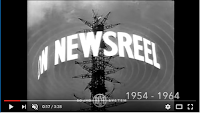 |
Showing technology and satellites connotes that they are using everything they can to deliver the news to you.
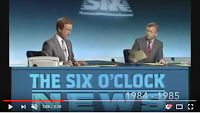 |
The use of male voiceovers connote both power and authority which again can show the importance of what is being said.
Beat-driven, fast-paced music that often involve brass instruments are used to grab the attention of the viewer and to announce themselves the beat often gives time.
 |
metallic blues and strong reds are used often and as the public world officials use these colors it grabs the attention of the viewer and shows it is official and important news.
 |
Newsreaders are supposed to deliver news in a 'transparent' manor to the viewer so should remain neutral and serious as well as delivering news with urgency and importance, this is done by limiting facial expressions and by being sat ready at their desk to deliver the news, they also show this by addressing you what seems directly as they look straight into the camera.
Tuesday, 14 March 2017
Documentary Formats
A documentary is a film, television or radio program that provides a factual report on a particular subject although these may be seen as biased, showing only information that the creator of the documentary believes to be true using a combination of editing, sources, therefore consciously or unconsciously putting bias into a documentary.
An expository documentary is a documentary that uses a series of informative images alongside a disembodied voice over that addresses the audience on what is happening directly the effect of this is objective with direct and transparent representation. An example of this is BBC One's Spy in the Wild, a documentary series in which animatronic spy creatures infiltrate the animal world to explore their complex emotions.
An observational documentary presents a non judgmental record of an event as there is no intervention by the filmmaker, they are hidden from the audience, the audience decide what to think. Because of this it depicted in a clear and unbiased way. Armadillo is a 2010 Danish documentary film about Danish soldiers in the War in Afghanistan directed by Janus Metz this is a purist observational masterpiece that has no voiceover, no narration, not even any interviews.
An Interactive documentary has the filmmaker as a participant they would have interaction with both the audience, interviewees and anyone else involved in the documentary. Because of the filmmakers presence it is argued that these types of documentaries manipulate what is being presented, rather than being factual it is more of a documented opinion. An example of an interactive documentary is A Journal of Insomnia, an NFB interactive documentary exploring mental health in the 21st century.
Due to the increased access to a production the audience can and will use social media to engage with content however they wish audiences are not just receivers of media anymore and instead can be anywhere from co-creators to learners to just fans and have more of a role to play in the creation of a production which may influence the people who are involved making it more biased.
A Reflexive documentary is a documentary that has interaction with the filmmaker who provides a narrative to expose what is essentially 'between the lines' of shots and documentation of everyday life these are experimented with in a way to present them as evidence that something else is going on.an example of this would be A Man with a Movie Camera (1929) where it shows scenes of city life in Moscow, Odessa and Kiev, and the credits describe it as an “experiment in cinematic communication of visible events”, which doesn’t do justice to its dedication to transforming and upending reality.
A Performative documentary has an obstructive nature and uses camera positions, soundtracks and re-enactments to show things in a more exaggerated manor and emphasizes truth as relative, favoring a personal take over the objective lens. The use of dramatisations and/ or reenactments are used to show what was happening in a way that is not just a re-telling of the story but it's very often over the top. A good example of a performative documentary would be Tongues Untied which blends documentary footage with personal account and fiction in an attempt to depict the specificity of black gay identity. The "silence" referred to throughout the film is that of black gay men, who are unable to express themselves because of the prejudices of white and black heterosexual society, as well as the white gay society.
Whilst I do believe that a documentarist should have a contract with the viewer to present them with authentic information showing only the truth, it is incredibly difficult not to have an influence over what you are showing as ultimately they decide what information is relevant for their documentary and either include it or discard it, they also decide how it is edited, what actions to shoot, where they place the camera and where their sources come from. so even if they believe they are presenting their documentary with no biases these factors all effect the authenticity of the piece and ultimately represent the filmmaker’s version of the truth.
Research Dossier
Secondary research
The Best of the Worst
So what are the worst gamer stereotypes? What are the things you’ve heard, seen or been guilty of yourself that shed a negative light on gaming and D&D? Once we identify them we can take steps to correct and debunk them.
Fat & smelly
It’s a common misconception that all gamers are overweight and that they have issues with personal hygiene. I’ll admit that I’ve seen (and smelled) my fare share of fat, smelly gamers but in my experience this is the exception rather than the norm. I think the stereotype persists because the only place a lot of non-gamers ever see us is at conventions. During cons a lot of gamers try so hard to jam pack as much fun into the few days they’ve got they go without food, sleep, a change of clothes or a daily shower.
Virgins
If you play D&D you’ll never get a girlfriend, let alone have sex. Considering how many gamers I know with kids I think we can safely debunk this myth. That’s not to say that every gamer is getting some, but in my experience the reason some gamers don’t have a significant other has nothing to do with their gaming hobby.
Socially Awkward
I guess this goes hand in hand with the virgin stereotype above. After all, if you can’t talk to people how are you ever going to talk to girls? It’s true that a lot of shy people play D&D, but I’ve found that they do so to overcome their shyness. D&D and RPGs in general allow people who aren’t good socially to come out of their shell by playing a character.
Basement Dwellers
If you’re a fat, smelly virgin with no social skills then you must live in your parent’s basement, right? Somewhere along the way people assumed that D&D was played in the deepest recesses of people’s basement, as if exposing a gaming table to sunlight would destroy it (or the players). The only reason I ever played in the basement was because there was more room there than at the dining room table and I could be as loud as the game deemed appropriate, even long into the night when others were sleeping.
D&D = LARPing
For the uneducated LARP is Live Action Role Playing. It’s a whole subset of D&D-like RPGs where people dress up as their character and physically act out their character’s actions, including combat and magic. People who LARP take it very seriously. But LARPing is not D&D. We do not dress up, we do not engage physically with other players. Our game takes place in our imaginations.
Devil Worshippers
In the 80s there was a lot of controversy around D&D being linked to Satanism and Devil worship. This was a case of a few bad apples spoiling the bunch. Religious groups used D&D as a scapegoat for the actins of a few misguided teenagers to smear the whole RPG community. Over time the fear and misunderstanding has declined, but some still hear D&D and associate it with Satanism.
Primary research
It was derived from miniature wargames with a variation of the Chainmail game serving as the initial rule system. D&D's publication is commonly recognized as the beginning of modern role-playing games and the role-playing game industry.
D&D departs from traditional wargaming and assigns each player a specific character to play instead of a military formation. These characters embark upon imaginary adventures within a fantasy setting. A Dungeon Master serves as the game's referee and storyteller, while maintaining the setting in which the adventures occur and playing the role of the inhabitants. The characters form a party that interacts with the setting's inhabitants (and each other). Together they solve dilemmas, engage in battles and gather treasure and knowledge. In the process the characters earn experience points to become increasingly powerful over a series of sessions.
Before the game begins, each player creates their player character and records the details on a character sheet. First, a player determines their character's ability scores, which consist of Strength, Constitution, Dexterity, Intelligence, Wisdom, and Charisma. Each edition of the game has offered differing methods of determining these statistics. The player then chooses a race (species) such as human or elf, a character class (occupation) such as fighter or wizard, an alignment (a moral and ethical outlook), and other features to round out the character's abilities and backstory, which have varied in nature through differing editions.
In 1979, 16-year-old child prodigy James Dallas Egbert III disappeared from his room at Michigan State University. A private investigator, William Dear, was hired by James's parents to find their son. Despite apparently knowing little about roleplaying games, Dear believed that D&D was the cause of Egbert's disappearance.
In truth, Egbert suffered from, among other things, depression and drug addiction, and had gone into hiding - in the utility tunnels under the university - during an episode of self-harm. The well-publicised episode - referred to as the Steam Tunnel Incident - prompted a number of works of fiction, including the novel Mazes and Monsters and 1982 Tom Hanks film of the same name.
Egbert later died from a self-inflicted gunshot wound in 1980. Despite the evidence regarding his mental health problems, some activists believed Egbert's suicide was caused by D&D.
Pulling described D&D as "a fantasy role-playing game which uses demonology, witchcraft, voodoo, murder, rape, blasphemy, suicide, assassination, insanity, sex perversion, homosexuality, prostitution, satanic type rituals, gambling, barbarism, cannibalism, sadism, desecration, demon summoning, necromantics, divination and other teachings".
The Best of the Worst
So what are the worst gamer stereotypes? What are the things you’ve heard, seen or been guilty of yourself that shed a negative light on gaming and D&D? Once we identify them we can take steps to correct and debunk them.
Fat & smelly
It’s a common misconception that all gamers are overweight and that they have issues with personal hygiene. I’ll admit that I’ve seen (and smelled) my fare share of fat, smelly gamers but in my experience this is the exception rather than the norm. I think the stereotype persists because the only place a lot of non-gamers ever see us is at conventions. During cons a lot of gamers try so hard to jam pack as much fun into the few days they’ve got they go without food, sleep, a change of clothes or a daily shower.
Virgins
If you play D&D you’ll never get a girlfriend, let alone have sex. Considering how many gamers I know with kids I think we can safely debunk this myth. That’s not to say that every gamer is getting some, but in my experience the reason some gamers don’t have a significant other has nothing to do with their gaming hobby.
Socially Awkward
I guess this goes hand in hand with the virgin stereotype above. After all, if you can’t talk to people how are you ever going to talk to girls? It’s true that a lot of shy people play D&D, but I’ve found that they do so to overcome their shyness. D&D and RPGs in general allow people who aren’t good socially to come out of their shell by playing a character.
Basement Dwellers
If you’re a fat, smelly virgin with no social skills then you must live in your parent’s basement, right? Somewhere along the way people assumed that D&D was played in the deepest recesses of people’s basement, as if exposing a gaming table to sunlight would destroy it (or the players). The only reason I ever played in the basement was because there was more room there than at the dining room table and I could be as loud as the game deemed appropriate, even long into the night when others were sleeping.
D&D = LARPing
For the uneducated LARP is Live Action Role Playing. It’s a whole subset of D&D-like RPGs where people dress up as their character and physically act out their character’s actions, including combat and magic. People who LARP take it very seriously. But LARPing is not D&D. We do not dress up, we do not engage physically with other players. Our game takes place in our imaginations.
Devil Worshippers
In the 80s there was a lot of controversy around D&D being linked to Satanism and Devil worship. This was a case of a few bad apples spoiling the bunch. Religious groups used D&D as a scapegoat for the actins of a few misguided teenagers to smear the whole RPG community. Over time the fear and misunderstanding has declined, but some still hear D&D and associate it with Satanism.
Primary research
Below I have included a flipsnack of the responses of a survey I have created to gauge interest from my primary and secondary target audience.
Script for
interviews – to be adapted during interview if necessary.
What is your
name and how long have you been playing D&D?
What is Dungeons
and Dragons?
Why did you
start playing Dungeons and Dragons?
Would you say it
has had an impact on the way people act towards you?
What sort of an
impact would you say it has had on you personally?
These are some of
the worst and common stereotypes of D&D players what are your thoughts on
these?
Fat &
smelly, Virgins, Socially Awkward, Basement Dwellers, D&D = LARPing, Devil
Worshippers
Tuesday, 21 February 2017
TV advertisement evaluation

We had been tasked to re brand an existing unilever product
to a different demographic to reach a different audience. After pitching our
ideas to each other and discussing how we could improve them we decided as a
group to re brand Brut. The original demographic was older males who are working
class so we decided to retarget it to a female audience of 16+ aiming
specifically at the working class. We decided to make females the new target
audience as this opens up a vast majority of the market that had previously
been neglected by Brut.
We collected feedback on our finished product by receiving a class critique. Some of the feedback we received was that the advert had smooth and pleasant camera movements accompanied by a good pace with the only complaint about the editing being on the music being unenjoyable and the focus pull seeming out of place. Some of the students that we received feedback from, who also fit our adverts new target audience, had commented on how we portrayed females in the ad stating that we did it in a positive light to empower females. Based on this feedback I believe that we managed to get the main message to the new target audience successfully.
We collected feedback on our finished product by receiving a class critique. Some of the feedback we received was that the advert had smooth and pleasant camera movements accompanied by a good pace with the only complaint about the editing being on the music being unenjoyable and the focus pull seeming out of place. Some of the students that we received feedback from, who also fit our adverts new target audience, had commented on how we portrayed females in the ad stating that we did it in a positive light to empower females. Based on this feedback I believe that we managed to get the main message to the new target audience successfully.
In our advertisement we used mise-en-scene well for both the dancing studio and the science lab by placing appropriate props in the scene like beakers and conical flasks as well as musical theater and dance posters. We managed to get smooth camera movements by using a dolly on a tripod, we also used focus pulls and panned for the establishing shot and thought a lot about composition. Whilst editing the shots together and playing it through we were able to find some music that went with the pace of the advert perfectly creating a calm and collected atmosphere.

 I feel that our advert doesn’t really sell the product as
effectively as it could although it is obviously aimed at a female audience and
does get the basic message across the slow pace of the advert doesn’t hold the
attention of the viewer all the way through the advert.
When trying to advertise this product we used persuasion techniques that
tells the audience that using Brut gives them confidence that enables them to
achieve what they want to achieve and I feel as if this was pretty effective as
the message was very clearly portrayed by two successful young women so that it
appeals to the correct audience.
I feel that our advert doesn’t really sell the product as
effectively as it could although it is obviously aimed at a female audience and
does get the basic message across the slow pace of the advert doesn’t hold the
attention of the viewer all the way through the advert.
When trying to advertise this product we used persuasion techniques that
tells the audience that using Brut gives them confidence that enables them to
achieve what they want to achieve and I feel as if this was pretty effective as
the message was very clearly portrayed by two successful young women so that it
appeals to the correct audience.Overall I believe that the advert is fit for purpose as it looks professional and complies with advertising regulations below you can see some of the general rules and when applying it to our advert you can clearly see we do not infringe:
3.1 Advertisements must not materially mislead or be likely
to do so. 3.2 Advertisements must not mislead consumers by omitting material
information. They must not mislead by hiding material information or presenting
it in an unclear, unintelligible, ambiguous or untimely manner. Material
information is information that consumers need in context to make informed
decisions about whether or how to buy a product or service. Whether the
omission or presentation of material information is likely to mislead consumers
depends on the context, the medium and, if the medium of the advertisement is
constrained by time or space, the measures that the advertiser takes to make
that information available to consumers by other means.
The final advert is quite different to what we had planned. Originally, we were going to have four actresses doing different activities, such as having one dancing, one doing sports, one to do with science and another to do with theater. However, we ended up with only two actresses, meaning that we had to reduce the roles that we showed. Despite this setback, we were complimented as we did not use sex appeal to sell the product but the influence of powerful and successful women.
Overall, I am satisfied with the advert, but if I was going
to do it again, then I would make sure to stick to the original plan and story
board I would also make sure that all talents are booked so that the advert would
apply to a larger audience. While I was absent for a lot of the lessons, I helped
with the pre-production work, such as the prop list and storyboards as well as the rough script. When it
came to editing, I gave my input and edited part of the advert too. helping with cutting and piecing together the advert and color correcting some of the shots which helped make it flow smoother.
Editing Task, analyzing
A Brief History of Editing:
Early on cameramen would make cuts in the camera by stopping cranking at the end of a shot and cranking the camera again when it was moved somewhere else. Paul's 'Cinematograph Camera No. 1' of 1896 was the first camera to feature reverse-cranking, which allowed the same film footage to be exposed several times and thereby to create super-positions and multiple exposures. One of the first films to use this technique, Georges Méliès's The Four Troublesome Heads from 1898, was produced with Paul's camera. And In 1899-1900 multi-shot films were definitively established by George Albert Smith and James Williamson. Smith made Seen Through the Telescope, in which the main shot shows street scene with a young man tying the shoelace and then caressing the foot of his girlfriend, while an old man observes this through a telescope. There is then a cut to close shot of the hands on the girl's foot shown inside a black circular mask, and then a cut back to the continuation of the original scene. Porter worked on a number of minor films before making Life of an American Fireman in 1903. The film was the first American film with a plot, featuring action, and even a closeup of a hand pulling a fire alarm. The film comprised a continuous narrative over seven scenes, rendered in a total of nine shots.[4] He put a dissolve between every shot, just as Georges Méliès was already doing, and he frequently had the same action repeated across the dissolves. His film, The Great Train Robbery (1903), had a running time of twelve minutes, with twenty separate shots and ten different indoor and outdoor locations. He used cross-cutting editing method to show simultaneous action in different places.
Visual Analysis:
There has been a system developed which enables the audience to understand the relationship shot to shot and makes a seamless effect whilst following the action this consists of; establishing shots, 180 degree rule, shot-reverse-shot, match on action and eyeline match cuts. You can see how these have been used in the above clip with the examples I have given below.
____________________________________________________
 |
| Establishing Shot |
At 0:12 you have an establishing shot, which uses a long shot at the beginning of a sequence to show where the location is as well as the time of day, so here it is the newly brought house of the couple in the middle of the day. This shot involves the use of screen time showing the inseparable two sharing precious time together.
____________________________________________________
 |
| Eyeline Match 1 |
At 0:06 you can see a very clear example of an eyeline match, this technique shows a person looking off in one direction in the first shot, here it would be Ellie and Carl looking off to the left, and then in the second shot it shows the space containing what that person sees or a person looking back in the opposite direction, here it would be their friends and family looking back at them.
 |
| Eyeline Match 2 |
____________________________________________________
 |
| Shot-Reverse-Shot 1 |
 |
| Shot-Reverse-Shot 2 |
* this is where a scene is constructed along an axis of action once the camera takes a position in relation to this axis, it should never cross it; this is the fundamental rule of respecting spatial continuity from shot to shot
____________________________________________________
 |
| Match On Action 1 |
At 0:04 they use a match on action technique where one shot cuts to another portraying the action of the subject in the first shot, here you see it in the form of a close up as Ellie is lowering Carl as she kisses him and in the next its a medium shot of her lifting him back up whilst releasing him from the kiss. This allows the audience's attention to be drawn away from slight cutting portraying a continuous sense of a single action rather than two.
 |
| Match On Action 2 |
This involves use of close-ups which is important for the viewer to make them more involved as not only will the be able to see the details of this person and the emotions they may be showing but the viewer is drawn into the subject's personal space and shares their feelings making them feel more connected.
_________________________________________________________________________
When generating appropriate involvement in the story line, pace, tension and suspense of a film you have to keep the audience interested in the main protagonist and to do this you have to make interesting things happen to them. Another thing to assist with this are the following editing techniques: shot variation, montage, providing and withholding information, parallel editing/ cross-cutting, editing rhythm, construction of the 'time' and 'space' of the story (diegetically & implied), cutting to soundtrack, multiple points of view, cutaway and jump-cuts.
By using shot variation the tone of the scene is set which lets the audience understand, usually very quickly, the concept of the scene. By using different shots throughout a film it enables you to get an understanding of your surroundings (long shots can achieve this) or even emotions the protagonist is portraying (close ups and medium shots can connote this), Disney Pixar's Up uses shot variation throughout the film and I believe it successfully depicts exactly what is intended for each shot.
In Shot 1 the use of a medium shot allows you to see the shock and disappointment on Carl's face as he makes an innocent mistake whilst simultaneously showing Ellie's surprised but still blissful expression. By doing this it shows the audience the love they have for one another as Carl tries his best to make everything perfect for Ellie and she is delighted about the effort he puts in despite any small mistakes made showing that within a singular shot you are able to progress the story line dramatically.
In shot 2 and shot 3 you are able to see, in this order, a close up and a long shot of the plans of the house they are to build together and the completed house. not only does this set the scene but this also develops the characters, and ultimately the story line, showing how hard they have worked for their shared dream.
They also used a montage of Carl and Ellie to show them overcoming hardships and growing old together further developing their story and keeping the audience interested with a variation of scenes that show a wide range of the protagonists emotions. The collection of clips played together generates suspense and excitement for the audience as they are left wondering what is going to happen next and as a lot of these show close-ups you feel very involved as if you went on the journey with them.
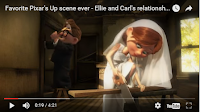
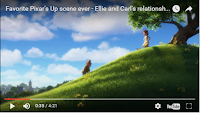
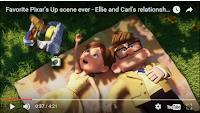
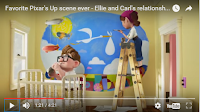


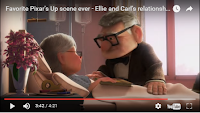
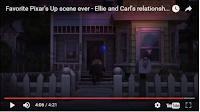
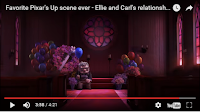
When generating appropriate involvement in the story line, pace, tension and suspense of a film you have to keep the audience interested in the main protagonist and to do this you have to make interesting things happen to them. Another thing to assist with this are the following editing techniques: shot variation, montage, providing and withholding information, parallel editing/ cross-cutting, editing rhythm, construction of the 'time' and 'space' of the story (diegetically & implied), cutting to soundtrack, multiple points of view, cutaway and jump-cuts.
 |
| Shot 1 |
 |
| Shot 2 |
 |
| Shot 3 |
They also used a montage of Carl and Ellie to show them overcoming hardships and growing old together further developing their story and keeping the audience interested with a variation of scenes that show a wide range of the protagonists emotions. The collection of clips played together generates suspense and excitement for the audience as they are left wondering what is going to happen next and as a lot of these show close-ups you feel very involved as if you went on the journey with them.









Subscribe to:
Comments (Atom)
